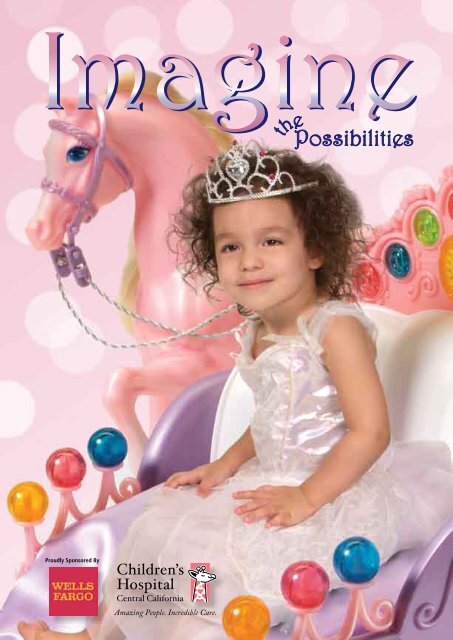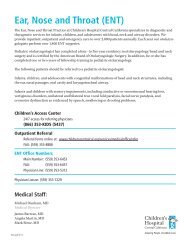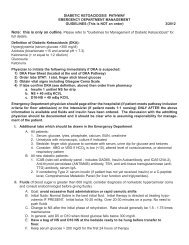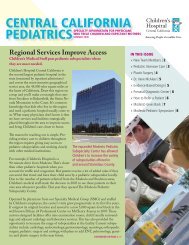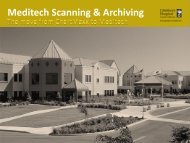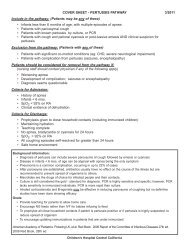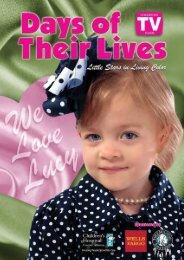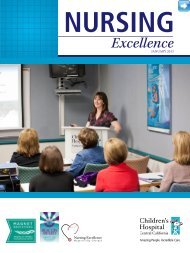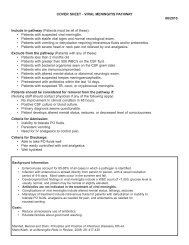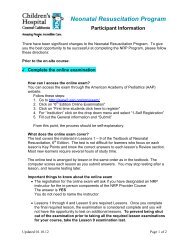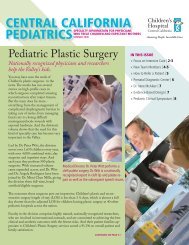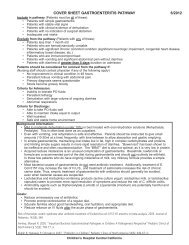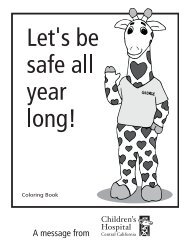Possibilities - Children's Hospital Central California
Possibilities - Children's Hospital Central California
Possibilities - Children's Hospital Central California
Create successful ePaper yourself
Turn your PDF publications into a flip-book with our unique Google optimized e-Paper software.
Imagination. Sometimes it seems like a mystical power that only kidspossess. You buy your daughter an expensive toy for her birthday and shefalls in love with the box. That box becomes a castle, a spaceship, a truck,a house – anything. That’s the power of a child’s imagination. The toy youbought is forgotten, the possibility of the box becomes the gift.You remember it, don’t you? You’re holding a basketball in your parent’sdriveway and counting down to the last shot. As you jump and throwthe ball in the air you become Michael Jordan or Larry Bird, the drivewaybecomes the arena, you can hear the fans, the ball swishes through the netand you raise your arms in victory. Or you’re reading Nancy Drew and youget the clue ten pages before Nancy does, and suddenly you’re figuring thewhole thing out, solving the mystery, and in your head, you are Nancy Drew.If you’re anything like me, you miss those days. But folks, let me tell you– that was practice for adult life. Every day we’re asked to turn what weonce called imagination into things we now call innovation, creativity andprogress. In our jobs, our homes and our personal lives we have to visualizeprogress before it can happen.More than fifty years ago five women visualized a hospital that would helpkids. That idea became Valley Children’s <strong>Hospital</strong>. Forty years later a set ofleaders saw progress as a technological marvel of a <strong>Hospital</strong> set on theriver bluffs north of Fresno. That idea became Children’s <strong>Hospital</strong> <strong>Central</strong><strong>California</strong>, an intellectual product of all the games those leaders used toplay. That idea, that splinter of imagination, became the building I workin today.Now I sit in my office, a product of vivid creativity, and whatdo I imagine?Well, let’s start with an immediate need. We built a fantastic EmergencyDepartment here, but we never anticipated the growth that would fill it up.Let’s imagine, shall we, an expansion? Why stop short – let’s imagine a bigone. A rebuilt Emergency Department that will see more kids faster, havemore doctors, more rooms, better equipment. Let’s not stop there. Let’s addrooms to our Pediatric Intensive Care Unit, so the seriously injured and illkids from the E.R. have someplace to go. Let’s dream up a new heliport forthose critical care transports. Just imagine the possibilities.The Imagination Team:Carol Logan - Art Direction & Design / Marlin Ezell - Writer / Lisa Baldrica - Project AssistanceSerena Smith - Project Assistance / James Gathright - Creative Direction / Kelly Peterson - PhotographyAnd that’s how it starts, every time. That’s imagination’s first step toward becominginnovation. That’s how creativity becomes reality. That’s how an idea becomes a placethat saves kids. In fairness, these ideas belong to a lot of people, but they are what weintend to do in the next few years. That’s right - we’re building a new dream, and weneed your help. In the next few years you’ll hear a lot about our expansion, and I wantthe adult in you to give way to the child and just imagine what we can do together.Why? Because of the kid with cancer who ”imagines” getting better, growing up.Because of the kid with asthma who ”imagines” breathing normally. Because of thefamily who imagines being home, together, without illness hanging over their heads.Imagination is just possibility hidden in the future. Children’s <strong>Hospital</strong> provides futuresfor kids who might not have them otherwise. We are all about imagination.Our doctors look at an illness or injury and imagine a treatment, a cure. Our nurses lookat a kid in a hospital bed and imagine a well-treated, comfortable child. Our entire stafflooks at a family with a sick child, and imagines them home and happy, together. Thenwe do everything we can to make it happen. And we thank you for helping us with that.When we call, help us fulfill the next stage of the dream. It really is up to you. You’re inthe driveway now, throwing up the shot. You’re Michael Jordan. You’re the hero whocan make our ”imaginary” scenario happen.You know what’s wonderful about being an imaginary hero?It’s just like helping Children’s <strong>Hospital</strong>. You never – ever – miss.Thanks,Bill HaugPresident and CEOChildren’s <strong>Hospital</strong> <strong>Central</strong> <strong>California</strong>Amazing People. Incredible Care.One of the largest hospitals of its type in the country, Children’s <strong>Hospital</strong> <strong>Central</strong><strong>California</strong> has become a champion of quality medicine, benchmarking our servicesagainst those of the nation’s top pediatric centers. Not only do we comparefavorably, we excel. Many of our services see more kids, and see sicker kids, thanother children’s hospitals, and still maintain high outcomes. In layman’s terms, ourwork is often harder but our results are at top levels.This quality is getting noticed nationally. We are the only children’s hospital westof the Rockies to receive the Magnet Nursing Services Award, meeting the highestnursing quality standard in the world.In the midst of this success, we always remember that our Children are not smalladults. Our specialists bring world-class training, experience and technology toevery child, combining state-of-the-art treatment and the brightest people witha hands-on healing approach. We know children’s health because it’s all we do.For more information about Children’s <strong>Hospital</strong> <strong>Central</strong> <strong>California</strong>, please visit ourwebsite at www.childrenscentralcal.org .CHILDREN’S HOSPITALCENTRAL CALIFORNIABOARD OF TRUSTEES 2007Chair, Mendy LavalVice Chair, Greg ColemanTreasurer, Jeff MayerSecretary, Octavia DienerBruce AllbrightJohn Caton, M.D.Dan DooleyGracie Esquivel Aguilar, M.D.John FerdinandiJane FortuneWilliam F. HaugDennis KellerDavid KrauseRobert Kubo, D.D.S.Richard PetersPat RicchiutiJ. Charles Smith, M.D.Bill SmittcampCHILDREN’S HOSPITALCENTRAL CALIFORNIAFOUNDATIONBOARD OF DIRECTORSChair, John FerdinandiVice Chair, George MurphySecretary, Susan BoydTreasurer, Michele WaldronImmediate Past Chair, Bruce Allbright, IIIPresident, William F. HaugMembers:Kim BeckErin BerberianMarty FlamingBob HallKenneth Jue, M.D.Robert Kubo, D.D.S.Jeff MayerPaul McDougalDavid NalchajianDave OlsonDennis PerkinsRichard ShehadeyDebbie Smades-HenesBill SmittcampNad Visveshwara, M.D.Keith WesternKevin WilliamsJody YoungJames Meinert, Ph.D.Vice President, Foundation
Each operation more painstaking thanthe last, cardiologists and cardiothoracicsurgeons at The Jane Seddon WillsonHeart Center at Children’s <strong>Hospital</strong> <strong>Central</strong><strong>California</strong> carefully fixed Seth DeSantis’heart, not once, but several times.Less than a year old, his pediatrician detected amurmur in his heart and recommended the familysee a specialist at Children’s <strong>Hospital</strong>.Children’s cardiologist James Prochazka, M.D.,confirmed that Seth had a membrane obstructingthe flow of blood in his tiny heart.“We knew we had to repair it. The membrane wascausing his heart to work harder,” says Dr. Prochazka.“There can be difficulty with the surgery because themain nerve that supplies the impulse for the bottomchamber of the heart to contract is right there,”explains Dr. Prochazka. “Another problem is thatdespite our best efforts, this membrane can recur.”Initially the tiny tot did very well. Dr. Prochazkaperformed careful follow-up and noticed therecurrence of the membrane blockage, plus thepatient’s valve was beginning to show some leakage.In April 2001, Dr. Petrossian and Frank Hanley, M.D.,performed a repeat operation. Doctors knew it wouldbe a delicate surgery.Because of the intricate work that had been donearound the heart nerves, cardiologists decided to put ina pacemaker as a backup a couple of years later.Never Missing a BeatThe Players: Doctors James Prochazka, Frank Hanley, Edwin Petrossian and The Jane Seddon Willson Heart Center at Children’s“This membrane creates turbulence that could destroyhis delicate aortic valve over time. If left untreated, hewould need valve replacement later in life.”“When Seth was first diagnosed, we were in shock,”says his mom, Julie. “We weren’t expecting that. Wewere told Seth needed surgery.”Children’s board-certified cardiothoracic surgeonEdwin Petrossian, M.D., performed the first of severalprocedures on Seth at the <strong>Hospital</strong> in February 1999.He carved out the membrane that was obstructing theblood flow in the young patient’s heart.Ultimately, Seth had an additional surgery performedthe following year to stop the leakage developing inhis aortic valve.“We’ve prevented a lot of damage that will pay off witha full and healthy life for Seth,” says Dr. Prochazka.Survival rates for Children’s cardiac patients are amongthe highest in the nation.“They don’t send you home until you’re better,” saysMom. “You go home healed.”Now, the third grade Century Elementary Schoolstudent never misses a beat. When he’s not havingsibling rivalry with his sisters Emily, 11, andVanessa, 14, he’s on the green practicing to be thenext world-class golfer.And he’s no hack. The 9-year-old’s pacemaker wascarefully placed so he could still swing the iron. “He’sgoing to be a great golfer,” adds Dr. Prochazka, one ofSeth’s biggest fans.Dr. Prochazka and the Heart Center team keep pacewith Seth through regular visits at The Jane SeddonWillson Heart Center at Children’s.Sponsored by“He’s one of our heroes,” exclaims Dr. Prochazka. “Heseems to face his adversity with a lot of courage.”Just as Seth plays to win on the golf course, so does thecardiology team when it comes to healing kids.
The Romos had no clue what was ailing their daughter, but the super sleuth medical team at Children’s<strong>Hospital</strong> <strong>Central</strong> <strong>California</strong> was able to detect the culprit and solve the mystery.About four years ago Diana Romo was a shell of hernormal self at the family’s home in Turlock. No one couldfigure out her mystery illness. Then the teen became tooweak to walk and started feeling a painful sensation inher leg. “I woke up one day and my leg was hurting a lot,”Diana recalls.At Turlock’s Emmanuel Medical Center, savvy doctorsknew she needed specialized pediatric care and sent her toChildren’s <strong>Hospital</strong> <strong>Central</strong> <strong>California</strong>.“The doctors and nurses at Children’s are verytrustworthy,” says her mother, Clemencia. “Theyspecialize in treating kids.”At Children’s <strong>Hospital</strong>, her condition looked grim.The Children’s team, including hematologist RobertMignacca, M.D. and the expert clinical team investigatedthe root cause of her ailment and discovered she hadDeep Vain Thrombosis, or DVT, in her left leg.DVT is a condition in which a blood clot forms in thedeep veins of the legs, pelvis, or arms. These veins arelocated near the bones and are surrounded by muscle. Itcan be life-threatening because the blood clot can breakloose and travel through the bloodstream to the pulmonaryartery in the lung, where it can block blood flow.Diana RomoClues led doctors to also discover that her clot formed inthe deep veins of her left leg as a result of an undiagnosedinflammatory bowel disease, called Crohn’s disease. It isa chronic inflammatory condition involving the smallintestine and can also affect the entire digestive tract.Symptoms include bleeding, chronic abdominal pain,diarrhea, fever, weight loss and anemia. Twenty percentof all cases of Crohn’s disease affect children.“It was a painful experience for our family, we weren’texpecting it,” recalls her father, Matias. “But the medicalstaff was so professional and kind. When it comes totreating children, they’re the best.”Diana spent five weeks at Children’s for her condition.Dr. Mignacca and the <strong>Hospital</strong>’s outstanding medicalteam gave her a lifesaving blood transfusion and treatedher existing clot with injections of blood-thinningmedications, called anticoagulants.“There’s lots of activities to do like watch movies,play videogames and play in the playroom.” saysthe soft spoken teenager about her experience atChildren’s <strong>Hospital</strong>.Due to her lifelong condition, Diana now visits theHematology Practice at Children’s every couple ofmonths. Dr. Mignacca and the Hematology teamkeep a watchful eye on her condition, conduct bloodcounts and adjust her anticoagulants to prevent newclots from forming.She is also treated by Dr. Jose Martinez at the <strong>Hospital</strong>’sGastroenterology Practice which provides comprehensivecare to children with gastrointestinal and nutritiondisorders, including Chrohn’s disease.Sponsored byRichard & Barbara Petersand FamilyThe young patient was so inspired by her experience atChildren’s that she wants to join the transport crew onAir George, the same lifesaving helicopter that rushed herto Children’s. A recent graduate of Pitman High School,the 17-year-old plans to attend Merced College andpursue a career as a nurse practitioner.The Players: Dr. Robert Mignacca and Children’s HematologyPractice and Dr. Jose Martinez of the Gastroenterology Practiceat Children’s
Talk about luck - Mason Mariscal is a veryfortunate boy.But in March of 2007, he needed more than luck.He needed the watchful eye of his preschooldirector, Cynthia Delgado, who saved his life whenhe stopped breathing.The tiny 3-month-old was in the middle of hispreschool naptime when Cynthia noticed he had turnedcompletely gray. She and one of Mason’s teachers startedCPR, called 911, and notified his mom, Kristy Mariscal.“They told me to come to the daycare center, there wasan emergency and I needed to be there right away,” saysKristy. “I arrived and a fire truck was there, I knew it waspretty bad.”By the time Kristy arrived Mason had been resuscitated,but the toddler was listless and unfocused. Heimmediately locked eyes on his mom when she pickedhim up, but had a seizure on the way to the ambulance.The medical team at Children’s conducted diagnosisprocedures on Mason and a Respiratory Syncytial Virus(RSV) test came back positive. Mason was placed inthe Pediatric Intensive Care Unit. For the next five daysdoctors, nurses, respiratory therapists and many otherprofessionals treated Mason and helped him avoidcomplications from infection. All the while, Tim andKristy stayed at his bedside.“Everybody’s so caring, you feel like they care about yourchild as much as you do,” says Mom. “They listen to youand ask lots of questions. It’s their goal to figure outwhat is going on.”There was more luck for Mason. During all of his testing,doctors made a fortunate discovery that might have goneunnoticed. The tyke had a heart condition called WolffParkinson White Syndrome, or WPW. It is a dysfunctionin the heart’s electrical conduction system, which canmake the heart beat too fast or at an uneven rate.Now Mason sees Children’s Cardiologist KennethRouillard, M.D. at the <strong>Hospital</strong>’s Pediatric SubspecialtyA Life Saving ExperienceThe Players: Children’s Pediatric Intensive Care Unit as well as Cardiologist Dr. Kenneth Rouillard and the PediatricSubspecialty Office in MercedMason’s father, Tim Mariscal, met Kristy and Masonat their local community hospital. In a very quick seriesof events, the family found themselves at Children’s<strong>Hospital</strong> <strong>Central</strong> <strong>California</strong> by the following day.“We had been there before with our oldest daughter,”says Dad. “I knew we were taking him to a good place.If there was anyone who could help him, it wouldbe Children’s.”Office conveniently located in Merced. Dr. Rouillardmonitors Mason’s heart using an electrocardiogram(ECG or EKG), which measures electrical activity.With a little more luck Dr. Rouillard believes Masoncould outgrow the condition within his first year. If thatdoesn’t happen it can be surgically repaired.When he’s not exploding with energy in his bouncer,he’s busy watching his seven and five year-oldsisters Caitlin and Lauren run around. He also loveswatching Seal, the British pop singer, perform on thefamily’s television.“When he starts getting fussy we’ll put Seal on and hestops crying, his attention turns to him,” adds Mom.Who knows, Mason could grow up to become a musicidol. With the kind of luck he has, the possibilitiesare limitless.Photo SponsorSponsored byBill & Linda Smittcampand Family
From the way she runs, jumps andhorses around, you could never tellthat this 2-year-old has a unique,inherited medical condition.Araceli Tason’s genetic condition, CysticFibrosis, was discovered before birth throughprenatal screening when her mother, EvangelinaTason, was four and a half months pregnant.Cystic Fibrosis is distinguished by an abnormality inthe body’s salt, water and mucus-making cells. It ischaracterized by the production of abnormallythick and sticky mucus which most frequentlyobstructs the lungs, leading to progressive chronicAraceli is in good hands with Children’sboard-certified pediatric PulmonologistsDr. Reddivalam Sudhakar, Dr. Lauro Roberto andDr. Mary Anne Tablizo. The trio provides a widevariety of services to children with respiratorydisorders like asthma. The Practice is also arecognized Cystic Foundation Care Center.Araceli’s routine includes frequent checkups andnutrition-monitoring. She has a high fat, highcalorie diet, and takes supplemental enzymesdesigned for her body. Due to her condition, anyillness can cause a respiratory crisis in the tinytot. When a respiratory infection slows her down,pulmonologists treat her ailment by identifying andcombating the bacteria.Photo SponsorPeggy, David,Ryan & MollyDunlapBack in the Saddle AgainThe Players: Doctors Reddivalam Sudhakar, Lauro Roberto, Mary Anne Tablizo and the clinical team at Children’sPulmonology Practiceand life-threatening lung infections. It also obstructsthe digestive system, preventing normal digestionand leading to malabsorption and malnutrition.About 2,500 babies are born with the chronicdisease every year.“We’ve been facing her illness with a lot of faith,”says her father Jose Tason. “Our faith has givenus the wisdom and knowledge to handle it.”Ever since the adorable youngster was born, she hasbeen a regular visitor at Children’s <strong>Hospital</strong> <strong>Central</strong><strong>California</strong>. Over that time she has weathered boutsof respiratory infections due to complications fromher condition.“They treat her well,” says her mother. “She is happy.Her happiness makes us happy.”At the family home in Fresno, Araceli enjoys playingwith her brothers, Reynaldo, 13, and 4-year-oldJose. She holds her own against them at the dinnertable, too.“She eats a little bit of everything,” says Mom.“Anything you give her she will eat.”With luck, the amazing care Araceli receives atChildren’s <strong>Hospital</strong> will keep her in the saddle foryears to come.Sponsored by
Megan Darcy found out she had diabetesthe hard way.She went into a diabetic coma. Time was of the essence.She was rushed to San Joaquin Community <strong>Hospital</strong>in her hometown of Bakersfield. Doctors diagnosedher with juvenile, or Type 1, diabetes, one of the mostcommon chronic diseases in children. It is estimatedthat one in every 600 children in the U.S. developsjuvenile diabetes. This happened in October 2003, whenMegan was only seven years old.The unconscious patient was airlifted to Children’s<strong>Hospital</strong> <strong>Central</strong> <strong>California</strong> - just north of Fresno - toreceive specialized pediatric care from EndocrinologistDr. Swati Banerjee. Children’s multidisciplinarytreatment team is highly experienced in the careof young diabetic patients. As soon as Air George,Children’s <strong>Hospital</strong>’s transport helicopter, toucheddown, Dr. Banerjee sprang into action.Type 1 Diabetes is the result of the body’s failure toproduce insulin, the hormone that allows glucose toenter the cells of the body to provide fuel. When glucosecannot enter the cells, it builds up in the blood causingthe body’s cells to starve to death. This is the result ofan autoimmune process in which the body’s immunesystem attacks and destroys the insulin producing cellsof the pancreas.Now 10 years old, Megan takes daily insulin injectionsand regularly monitors her blood sugar levels. Shedemonstrates with a quick prick from her pocket-sizeglucose monitor.“One-hundred and nine,” she says positively, afterreading her blood sugar level on the small monitor.“My range is 70 to 150 now.”She continues to visit the <strong>Hospital</strong>’s Diabetes andEndocrinology Practice every three months, whereSwing Into ActionPhoto SponsorEarl & MurielSmittcampThe Players: Dr. Swati Banerjee and the Diabetes and Endocrinology Practice at Children’sMegan was stabilized and then hospitalized for fourdays. Dr. Banerjee started a treatment regime thatbrought Megan’s blood sugar level within normal ranges.When she came out of the coma – her family at herbedside – the first thing she asked for was one of herfavorite foods, cottage cheese and peaches.“Dr. Banerjee is wonderful,” says her great-grandmother,Trudie Gregory. “The doctors and nurses were all rightthere, everyone was so helpful. You couldn’t ask for abetter hospital.”Dr. Banerjee monitors her condition. An accreditedAmerican Diabetes Association Center of Excellence,the Practice specializes in diagnosis and management ofchildren with diabetes or endocrine disorders.Besides pausing to monitor her glucose regularly,Megan is constantly on the go. When she’s not involvedin Girl Scouts, she’s busy giving her dog Shaggy lotsof affection. Swimming and shopping are also highpriorities, particularly at the Build-A-Bear Workshop.“I’m a Build-A-Bear fanatic,” exclaims Megan. “Ihave 14!”With her condition under control, the soon to be 6thgrade student at McKee Elementary School is morepopular than ever. “I like to talk a lot,” she says, smiling.But don’t let the social butterfly fool you. In school, sheexcels academically, earning A’s and B’s in class.“Mostly A’s,” says her great grandfather, James Gregory.“Her great-grandmother keeps her going.”And the academic all-star has a plethora of awards andachievements to prove it, from Honor Roll certificatesto Perfect Attendance honors.Sponsored byWith her personality and brains, along with theexcellent medical care she receives at Children’s, Meganwill surely catapult herself into a successful future.
One could say Isaac Orozco has a nosefor trouble.The 5-year-old was playing at his home in theMerced County town of Gustine in April when hestarted complaining about pain in his nose.“He had a habit of poking things in his nose,” sayshis mother Maria Orozco. “I thought he had pokedhis nose with one of his toys.”Later that night the boy began to seemuncomfortable. His mother and father,Antonio, realized that their son’s nose wasswelling and had begun to drain.Orozcos to Children’s <strong>Hospital</strong> <strong>Central</strong> <strong>California</strong>.For Maria, the drive to the <strong>Hospital</strong> just north ofFresno was an emotional roller coaster.“On the way to Children’s I was crying, I thoughtsomething was going to happen to him,” said Maria.“I was scared because doctors told me that if thebattery opened inside of him it could damage hisnose and he might have to have surgery. They alsosaid it could go down his throat and even openinside his body. It could be deadly.”Board-certified Ear, Nose and Throat specialistDr. Michael Dunham was waiting for Isaac. Beforepreparing him for the procedure to remove thebattery, <strong>Hospital</strong> staff talked to the youngster andBreathing EasyThe Players: Dr. Michael Dunham and Children’s Ear, Nose and Throat Practice“I got worried and I asked him ‘what did you put upyour nose?’” Maria said.Isaac took his mother to his room, pulled a secondbattery from his toy watch and showed her. “This iswhat I have up my nose,” he said.“The battery was so far up we couldn’t see anything,”said Mom. “I got scared and rushed him to thehospital in Los Banos.”At Memorial <strong>Hospital</strong> Los Banos doctors tried toremove the battery to no avail. They referred theISAACOROZCOSponsored byDavid & LisaKrauseshowed him what was going to be done. Theyexplained it to him like it was going to be a game.“He was OK with it. I felt really good about itbecause he wasn’t screaming or crying.” Maria said.Children’s staff knew just what to do. Isaac was givenanesthesia and Dr. Dunham removed the battery inless than 10 minutes.“I have never been to a hospital where they treatyou so well and so fast. He was treated reallyspecial,” Maria passionately says. “From nowon if any of my kids get sick, I’d rather drivestraight to Children’s.”Isaac is seen for follow up care by Dr. Dunhamand the talented team in the Ear, Nose and ThroatPractice for follow-up care every three months. Theteam treats many children who not only poke thingsin the wrong places, but also swallow dangerousobjects, so Isaac’s parents warn everyone to keep aclose eye on their kids.The curious boy is back home under the verywatchful eye of Mom, Dad, and his 8-year-oldbrother Anthony. One thing is for certain, Isaac haslearned his lesson, and nothing gets near his noseanymore. Now everyone is breathing easier.Photo Sponsor
Sereykunthea Ry’s symptoms had herall tied up in knots.The 13-year-old Fresno girl took a turn for theworse when she developed flu-like symptoms, fever,chills and stomach-aches, as well as an abscess onher neck.“I was at home playing and my stomach startedhurting,” says the teenager. “A few weeks later therewas a bump on my neck.”On doctor’s orders, it was off to Children’s <strong>Hospital</strong><strong>Central</strong> <strong>California</strong>. The teenager was admitted andInfectious Disease physician Dr. James McCartyhad x-rays performed, revealing inflammation in herchest as well as an infection in her throat.The family’s world was twisted and turned upsidedown at the news of their daughter’s illness. “I justwanted to make sure she was OK,” says her mother,Savoeun. “At Children’s <strong>Hospital</strong>, I knew she was ingood hands, I wasn’t worried at all. They really tookgood care of her.”The disease usually causes flu-like symptoms andcan sometimes affect the lungs. Some may developa serious or even fatal illness such as severe lungdisease requiring hospitalization. A small percentageof those infected can develop chronic Valley Feverthat spreads outside the lungs to the brain, bone andskin. Without proper treatment, it can lead to severepneumonia, meningitis and even death.The young patient finally took a turn for the betterafter more than two weeks of care at Children’s.Dr. McCarty and staff aggressively attacked theA Twist of FateThe Players: Dr. James McCarty and the Infectious Disease Practice at Children’sDr. McCarty and his team in the Infectious DiseasePractice took culture samples and diagnosedSereykunthea with Valley Fever. Valley Fever iscaused by a fungus that grows naturally in soil in thesouthwestern U.S. and produces spores that can beinhaled when they get into the air.illness with doses of antifungal medications to killthe fungus and treat the underlying infection.Sereykunthea’s father, Bo, frequently visited and hermom stayed at her bedside until she started gettingbetter. Then the teenager’s mother would go homeand cook her daughter’s favorites – rice, chicken andsoup – and bring them back for her to eat.“Dr. McCarty and the nurses are very caring, theyshow emotionally that they care,” says her mother.“Dr. McCarty came and talked to her when she wassad. When they see that children are sad they willcheer them up and raise their spirits.”Back on her feet again, she headed home wherebrothers Ratha, Chetha, Somta, Sinty and her dogTickle anxiously awaited.Sponsored byJames & Barbara Meinertand FamilyThe teenager’s life is anything but ordinary nowthat she has to adjust to the special challengesassociated with her condition, such as the antifungalmedication she continues to receive at Children’sthree times a week. But her condition is treatableand she won’t have the disease for a lifetime, andthat’s a great twist at the end of the story.Photo SponsorKathleeen L. Behr, M.D.Dermatologic Surgeon
A few frames back, things weren’t looking sogood for Dallen McEntire. The 12-year-oldwas struck by a boat while knee-boarding withhis family at Shaver Lake. It was the worstpossible scenario - the propeller hit his head.“The boat came out of nowhere, made a hard turn anddidn’t see him,” says Dallen’s father, Jeff McEntire.“I tried yelling at the boat to stop. The boat wentright over him.”The hit and run victim was pulled out of the waterin critical condition. He spent more than a month atChildren’s <strong>Hospital</strong> <strong>Central</strong> <strong>California</strong> fighting for hislife in the Pediatric Intensive Care Unit (PICU).Children’s Neurosurgeon Dr. Meredith Woodwardwas joined by plastic surgeon Dr. Peter Witt. WhileDr. Woodward managed the neurosurgical aspect, theexperienced plastic surgeon fixed Dallen’s orbit and bone,and then repaired the soft tissue.“It wasn’t a clean cut. It was a twisting, pulling lacerationthat actually avulsed a substantial portion of the toughcover overlying the brain,” recalls Dr. Witt. “It becamean interesting and challenging surgical procedure.”Dallen is just one of the many miracles to come fromChildren’s Plastic Surgery & Craniofacial Practice.Led by Dr. Peter Witt and Dr. Angela Rodriguez, themedical team provides a wide array of complex andA Miraculous TurnaroundThe Players: Dr. Peter Witt of Children’s Plastic Surgery & Craniofacial Practice, along with Children’s Neurosurgeon Dr. MeredithWoodward and the medical staff of the Pediatric Intensive Care Unit“I honestly thought he wasn’t going to make it. Doingwhat I do for a living, I’ve seen it all too many times.People usually don’t survive that kind of trauma,”says Dallen’s father, a firefighter in their hometownof Bakersfield. “Once he came out of the PICU, histurnaround was remarkable.”A miraculous feat, considering the extent of his injuries.The propeller had gone completely through his skull,shattering the orbit (the bony structure that houses theeye), creating an enormous laceration. The cut went fromhis scalp, across his entire forehead, crossing his nose andcurving under his left eyelid, over to the side of his face.Dallen was in a unique situation that requiredneurosurgery and facial reconstruction to happenat the same time.routine surgical services for congenital deformities andtrauma-related injuries.Dallen’s family credits the hospital and the exceptionalcare he received from the medical team.“We’re very fortunate he went to Children’s,” Jeffexplains. “I don’t think the outcome would have beenthe same had we gone to another hospital. They caterto kids, that’s their whole reason for being here.”The family is also extremely grateful for the support theyreceived from the entire Valley, from the Bakersfieldcommunity to the Fresno Fire Department.Click forward a few frames to today and things lookmuch better for the miraculous survivor. He’s back toriding dirt bikes, playing football, taking care of his dogsand playing with his 10-year-old brother, Blake.At Rio Bravo-Greeley School, Dallen has finished 6thgrade, where his academic accomplishments earnedhim a spot on the President’s List – thanks to hismother’s persistence – for achieving an exceptionalgrade point average.Photo SponsorFor now, he’s taking life one frame at a time.Sponsored bySponsored by:
Strawberry Shortcake and SamanthaManriquez are a lot alike, both like pink,both have an adorable character and bothhave a pet cat, but the pretty in pink patientwould soon find out that she had onemajor difference.“She was a healthy little girl in 2003 when she got acold, it became strep throat and she had a hard timebreathing,” says her mother, DeAnna Manriquez.The 3-year old also had aches in her bones andcomplained that her legs bothered her. ”One week shewould be fine and the next she would be really sick,”recalls Samantha’s father, Sonny Manriquez.She had difficulty swallowing that ended in a tripto her pediatrician. The doctor checked her throat– Samantha’s tonsils looked like blue cheese. It was abad case of strep throat.result of a larger problem. Children’s <strong>Hospital</strong>Hematologist and Oncologist Robert Mignacca,M.D., diagnosed Samantha with Acute LymphocyticLeukemia, or ALL. It’s the most common type ofchildhood cancer, accounting for nearly 75 percentof all childhood leukemia cases. ALL is cancer of theblood and develops in the bone marrow. This form ofthe disease affects the white blood cells causing them tooverproduce malignant and immature cells, crowdingout other blood cells in the bone marrow. It spreads tothe bloodstream and other vital organs quickly, and isdeadly if not treated.“I just thought to myself, be as positive as possible toget her through this,” says Sonny.Treatment for Samantha included antibiotics forthe infection in her lymph nodes, followed bychemotherapy at the Craycroft Cancer Center atChildren’s <strong>Hospital</strong>. The Center is a full member of thenational Children’s Oncology Group (COG), whichPhoto SponsorA Good PrognosisThe Players: Doctors Vonda Crouse, Cris Johnson, Robert Mignacca and The Craycroft CancerCenter at Children’sThe doctor prescribed medicine but her condition didn’timprove. A second visit to the pediatrician revealed theimmediate need for hospitalization.At Children’s <strong>Hospital</strong> <strong>Central</strong> <strong>California</strong>, she had aseries of tests, including CAT scans, MRI’s and bloodwork to check for cancer. Meanwhile the young patientwas not herself, completely out of it.It was a shock to the Manriquez family that theinfection they worried about turned out to be theutilizes the latest treatment and research protocolsavailable for treating childhood cancer.“They treated us like family, they were right therewith us,” says Dad. “From doctors, to nurses, even thecafeteria staff, they’re really good people.”After the intense and successful treatment, Samanthastill sees Oncology doctors Vonda Crouse andCris Johnson at Children’s for chemotherapy andmonitoring.The 8-year-old is back to talking on the phone, dressingup and listening to music at the family’s home inMadera. She receives ample support, not only fromher mother and father, but also from her 3-year-oldsister, who adores her and emulates everything she does,including eating her favorite food, white rice.Samantha has a lot of patience with her sister, whichwill help her when she grows up.“I want to be a teacher,” she says.Sponsored byJim and MariePardiniThanks to prompt medical attention, aggressive therapyand continuous follow-up care, Samantha’s prognosis isgood. “Doctors have high hopes that she is going to beable to live a long, healthy life,” says Mom.
Less than a year and half old, Khai Brownis a ball of energy. With a radiant personalitythat rivals the gaping smile on Mr. PotatoHead, not even asthma can slow thisactive boy.“He’s really hyper, even when he is sick,” says hismother, Leah Brown.Khai suffered his first asthma attack when he was justover six months old. After catching his first cold, theoutgoing youngster was sick for two weeks, coughingand wheezing.“I came home from work one day and he waswheezing,” says his mother. “I was really worried.He was coughing so hard he couldn’t even catch hisbreath or hold his food down.”the diagnosis and treatment of children withrespiratory disorders.The toddler was hospitalized for three days and twonights and treated with medications to help decreasethe inflammation in his airways, open his narrowedlungs, and relieve his coughing, wheezing anddifficulty breathing.“The medical staff at Children’s is very compassionateand understanding. It’s comforting knowing thatthe <strong>Hospital</strong> is right there,” exclaims Mom. “I can’timagine him having an asthmatic episode and being inanother hospital.”Children with asthma have acute episodes whenthe air passages in their lungs become narrowerand breathing becomes more difficult. The lungsand airways overreact to certain triggers - likeBreathing a Sigh of ReliefThe Players: Doctors Reddivalam Sudhakar, Lauro Roberto, and Mary Anne Tablizo of the Pulmonology Practice at Children’sAt Children’s <strong>Hospital</strong>’s Emergency Department,Khai was put on a continuous breathing treatmentto ease his breathing difficulties and stabilize hisoxygen level.“The medical staff started giving him oxygen with hisbreathing treatment,” recalls Leah.Khai was diagnosed with asthma by Children’spulmonology care team which includes ReddivalamSudhakar, M.D., Lauro Roberto, M.D., andMary Anne Tablizo, M.D. The team is skilled inenvironmental, infectious, and chemical factors -causing the lining of the airways to become swollenand tight. Approximately 20.5 million people in theU.S. have been diagnosed with asthma.After his release from the <strong>Hospital</strong>, Khai’s lifereturned to a high-paced adventure at the family’shome in Fresno. He exerts his energy playing andhaving buckets of fun with his 5-year-old brotherKeith and sisters Keileah, 6, and Kariah, 4.Khai and his family can breathe a sigh of relief thanksto the physicians at the Pulmonology Practice whomanage his disease by monitoring his condition,prescribing medications to control and treat hissymptoms, and working with the family to identifytriggers and warning signs. Like all asthma patients,Khai is learning that controlling the condition is muchbetter than treating attacks.For some children, asthma improves during theteenage years. “I’m still crossing my fingers that hewill outgrow it,” says Leah. But if he doesn’t, thepulmonology team at Children’s will always be thereto help.Photo SponsorKevin & Denny Tweedand FamilySponsored by
Born a sturdy 8 pounds 2 ounces, JessicaCaplener wasn’t the picture of health.Shortly after birth, she started turning blue,her body wasn’t getting enough oxygen.the addition of Dr. Owada and the new CardiacCatheterization Laboratory at Children’s in 1997.“They are very organized and professional but alsokind,” says her mother, Nancy Caplener.“She had no artery from her heart to her lungs, alethal condition,” says Children’s cardiologistDr. James Prochazka. The newborn was diagnosedwith a congenital heart defect. There was no wayfor blood to travel from the heart to the lungs to berefreshed with oxygen.“Dr. Prochazka told us that there’s hope,” recalls herfather, Ronald Caplener. “He got us to realize thatgood was going to come from it.”Jessica had a series of staged operations, essentiallyreassembling her pulmonary arterial system. Theoperations started in the 1990s in Southern <strong>California</strong>.Twelve years and still on a roll, the dependableDr. Prochazka and Children’s cardiology teamcontinue to give Jessica checkups every six monthsand monitor her condition.“Jessica’s done very well following her reconstructiveprocedure,” says Dr. Prochazka. “We’re extremelyproud of her outcome. She has no symptoms.”“Children’s has been her home base, we wouldn’thave it any other way,” says Ronald. “It’s not a big,scary place. You walk in and see kids being pulledin wagons.”Easing the LoadPhoto SponsorThe employees ofParamount Agribusinessand the Paramount familyof companies.The Players: Dr. Carl Owada, Dr. James Prochazka and the physicians and surgeonsof the Jane Seddon Willson Heart Center at Children’sThe first operation was at UCLA, and all subsequentsurgeries have been at The Jane Seddon Willson HeartCenter at Children’s <strong>Hospital</strong> <strong>Central</strong> <strong>California</strong>,among the best in the U.S. for treating congenitalcardiovascular disease. Children’s maintains someof the highest survival rates among children’shospitals nationwide.Hampered by early complications, Jessica pulledthrough and recovered. Dr. Prochazka managed hercondition, treating her with heart medications betweensurgeries while Children’s cardiologist Dr. Carl Owadaand the cardiology team completed the surgicalcrafting to reconstruct the flow of blood to andwithin her lungs. Jessica’s progress was aided byThe family recently attended an air show where Jessicaand her father went for a ride on a 1929 vintage planeand a helicopter. “I was a little nervous about that,”she admits.Jessica is firmly grounded in her real passion,photography. The creative left-hander roams aroundthe family’s home in Merced with her camerasnapping photos.“I like taking photos of my dog and my cats,” says theaspiring photographer.Now the picture of health, she could become the nextAnsel Adams, leaving a trail of artwork that couldsomeday be prominently displayed at Children’s forfuture cardiology patients – like herself – to admire.Sponsored byMax & MartyFlaming
Justin Zapata is tougher than aTonka truck and has enough medicalrecords to fill one, too.He came into the world with Pierre Robin Sequence,a combination of birth defects that begins duringpregnancy with a small jaw. As an infant, he spentthe first couple of months of life in the NeonatalIntensive Care Unit at Children’s <strong>Hospital</strong><strong>Central</strong> <strong>California</strong>.“He wasn’t breathing when he was born,” recallshis mother, Cindy Zapata. Because of his jaw, therewasn’t enough room for his tongue to lie flat, causingit to fold up and rest at the back of his mouth,blocking his airway. Due to his troubled breathing,he had to have a tracheotomy to assist him.successes to come from doctors Angela Rodriguezand Peter Witt in the Plastic Surgery & CraniofacialPractice at Children’s. This amazing team repairedJustin’s cleft palate when he was less than a year old.Justin also had two surgeries to extend his lower jawand help it grow.“The treatment has been really good, the way thedoctors treat my son is the way they would treat theirown child,” says Cindy. “The medical staff is verythorough. They take the time to answer all ofyour questions.”Justin’s trekked a lot of miles at Children’s for otherproblems associated with his Pierre Robin Sequence.He’s a patient at the <strong>Hospital</strong>’s Charlie MitchellChildren’s Center, Urology Practice, GeneticMedicine and Metabolism Practice, Diabetes andEndocrinology Practice, and Speech Services.Photo SponsorTough Little TykeThe Players: Children’s Plastic Surgery and Craniofacial Practice including doctors Angela Rodriguezand Peter Witt, as well as Children’s Neonatal Intensive Care UnitPoor feeding as a baby was also a problem. Not ableto get enough nutrition by mouth, a gastrostomytube (G-tube) was surgically inserted into hisstomach when he was just two weeks old. The G-tubeprovided all of his nutrients.Because his tongue couldn’t lie flat, it also preventedthe roof of his mouth from closing, resulting in acleft palate.That he can smile, talk and eat today is somethingof a miracle for the 4-year-old, one of the manyTracheotomy and G-tube free for almost two yearsnow, Justin’s mother will admit that the tough littleguy has a soft spot for Chicken McNuggets. “Wejust started him on anything he would eat because hewasn’t eating by mouth for so long,” adds Cindy.“We always talk about him being a doctor justbecause he’s been through so much,” says his mother.For now, he’s content shifting gears and catching upon his childhood, which includes playing basketball,soccer and Tee Ball when he starts school in thefamily’s hometown of Fresno.“His favorite thing to do is play basketball and go toFresno State Bulldog basketball games,” says Mom.In fact, Justin goes about his life growing up asnormally as possible, with the exception of hismenagerie of pets that includes a cow, peacocks, adog, chickens and cats.Sponsored by“I just want to thank Children’s <strong>Hospital</strong>, they’vebeen great to me and my family,” says Cindy, whois also an employee working in Children’s PatientAccounting Department. “I feel like I’m workingfor an organization that believes in taking care oftheir patients.”
On the road to recovery, Bryanna Baeza’sbouncy journey has landed her atChildren’s <strong>Hospital</strong> <strong>Central</strong> <strong>California</strong>.The usually energetic 9-year-old wasn’t herself inMarch of this year. She was vomiting and wasn’teating. All she wanted to do was lay down.A hasty trip to the hometown physician in Mendotarevealed little. The symptoms looked like a normalchildhood illness.But her condition worsened. Bryanna’s mother,Olga Baeza, decided to take her daughter to theemergency room at St. Agnes Medical Center inFresno. “They did some blood work and told me thather kidneys weren’t functioning,” said Olga.From there, doctors immediately transported herChildren’s Nephrology team – pediatric specialistswho focus on kidney disease and disorders – aggressivelytreated her with fluids, antibiotics and dialysis.Just as the little patient was beginning to rebound, sheexperienced respiratory problems and woundup back at Children’s <strong>Hospital</strong> for another coupleof weeks.“All of the doctors who cared for Bryanna werereally good,” said Olga. “They are professionals intreating children.”Bryanna’s mom credits the nephrology specialists andher daughter’s supercharged resilience in helping herbounce back.“The nurses there at the PICU (Pediatric IntensiveCare Unit) were really good too,” recalls Olga. “TheySupercharged ResilienceThe Players: Doctors Jerome Murphy, Syed Kamal and the medical staff at Children’s Nephrology Practiceby ambulance – a hop, skip and a jump away – toChildren’s <strong>Hospital</strong> <strong>Central</strong> <strong>California</strong> to receivespecialized pediatric care.Bryanna was in the hospital for a month under thecare of the Children’s dynamic duo, NephrologistsDr. Jerome Murphy and Dr. Syed Kamal. She hadStreptococcal Glomerulonephritis, an infection of thekidney, which led to kidney failure.In addition to the infection, her electrolytes wereout of balance, she was severely anemic, and she hadsevere high blood pressure – all things controlled byher kidney. Worse, she also had a stroke and sufferedfrom seizures due to clotting and bleeding problems.talked to me about everything that was going on andeverything that was going to happen to Bryanna.”Back in the comfort of her home, Bryanna receives10 hours of peritoneal dialysis every night. A specialmachine removes waste substances and fluid from herblood that are normally eliminated by her kidneys.She’s back to doing what she loves, going shoppingand buying Bratz dolls, as well as eating her favoritefood, spaghetti.“In the beginning it was bad but now she’s acceptingit,” says Olga. Thanks to the support from her mom,dad, her older sister Ruby and older brother Javier,combined with the exceptional care she receivedat Children’s.She visits the Nephrology Practice monthly whereNephrology Medical Director Dr. Jerome Murphyand Dr. Kamal continue her treatment. “She isdoing very well,” adds Marion Marino, RN, dialysiscoordinator at Children’s Dialysis Center.Due to the extent of her condition, Bryanna willrequire a kidney transplant. But the family is hopeful.“If I’m compatible and I’m healthy enough, I’m goingto donate my kidney to her,” says her mom.Sponsored byNow mom admits that Bryanna’s a superchargedhandful, but smiles and says she wouldn’t have it anyother way.
Miles Gentry was swollen like a wet andbloated Nerf ball.“It all started in September 2005, with what lookedlike a flea bite on his ankle,” says his mother, Lisa.“We took him to the emergency department atMemorial Medical Center in Modesto. Themedical staff thought it was an infection and gaveus antibiotics.”But Miles wasn’t getting better. He developed a102 degree fever that wouldn’t break.“He’d play all day and was normal, but as soon asnight came, his ankle would hurt and swell so badhe couldn’t even walk,” says Lisa. “We went back toMemorial, they knew something was wrong.”“He went from 68 pounds to 98 pounds in a week,his kidneys weren’t working,” says his father Danny,a truck driver who was in Seattle at the time andrushed back to Miles’ bedside. “It was the mostdifficult moment of our lives.”The bloated youngster had Class IVGlomerulonephritis, one of the most severetypes of kidney disease that affect children withLupus - fatal if not treated. Miles was givenmedications to help his kidneys and remove excessfluids. An astonishing 12 liters was drained. “I was anervous wreck,” Lisa recalls. “The nurses really helpedme out a lot through the support they gave me.”After being hospitalized for three weeks and receivingspecialized care, Miles bounced back.B o un cin g Ba ckPlayers: Dr. Dowain Wright and the Immunology and Rheumatology Practice at Children’sMiles was tested for Lupus, an autoimmunedisorder that causes the body’s immune system toattack healthy cells and tissues. It is characterizedby episodes of inflammation and damage to joints,tendons, and other connective tissues and organs. Theheart, lungs, kidneys and brain can be most affected.The tests were positive.Memorial referred Miles to Children’s <strong>Hospital</strong><strong>Central</strong> <strong>California</strong>’s board-certified RheumatologistDowain Wright, M.D., Ph.D., who specializes intreating children with rheumatic diseases like Lupus.“The morning of his appointment, he woke up andlooked like a blowfish. His face was so swollen,” sayshis mother. “He couldn’t even walk.”“I call him my ‘poster child’,” Dr. Wright says.“I can’t believe what a turnaround he has made.”Miles is now a frequent follow-up visitor at theRheumatology Practice.“He’s really doing well now,” says his mother, Lisa.Miles is back to tending his cats Spanky andWhiskers, eating his favorite food, Chinese, andplaying with his older brother Kyle. The 3rd grader atFairview Elementary School loves basketball, and forgood reason.“I’m the tallest in the class,” Miles confidentlypoints out.He always wears a hat and sunscreen, but the futurelooks bright for the tall youngster who learned thatsometimes when you hit bottom, you bounce back.Photo SponsorJeff & MelanieMayerSponsored byDrs. Eileen & William Hennrikusand Family
Though blessed with the looks of a doll – anangelic face and brown eyes – MichaelaLozano’s world has been far from the perfectimaginary world of Barbie and Ken.Michaela has Intractable Complex Partial Epilepsy,with a Bilateral Foci – a unique neurological disorder,involving recurrent seizures. To make matters worse,she has drug-resistant or “intractable” epilepsy. “We’vetried almost every medication there is,” says her father,Donald Lozano.Normally, one part of the brain misfires, but inMichaela’s condition the temporal lobes – the areaof the brain that controls emotion and memoryfunction – on both sides of her brain misfires.In order to diagnose her condition, Children’sneurology team had to catch a seizure in progress toprove it was epilepsy. The team performed a videoelectroencephalogram (EEG), a lengthy process inwhich Michaela was videotaped while her EEG wasrecorded. An EEG measures the electrical activityin the brain.Only three months old in January 2005, the young girlsuffered her first seizure at her grandparent’s house. Aweek later she had another.TMAKINGMichaela’s been to the <strong>Hospital</strong> numerous times for herseizures. “The first year she had over 20 admissions,”recalls her father. Neurologist Dr. Steven Ehrreich andstaff at Children’s Neurology Practice used medicationREMENDOUS STRIDESDr. Steven Ehrreich and staff at Children’s Neurology Practice, alsoChildren’s Emergency Department and Children’s Outpatient Therapy Services“We had never seen a seizure. We really didn’t know theseriousness of it in the beginning,” says Donald. “Wedidn’t understand the severity of it.”The family chose to take Michaela to Children’s<strong>Hospital</strong> <strong>Central</strong> <strong>California</strong> because of the <strong>Hospital</strong>’sreputation for treating children.“We had no idea of what was going on,” says Michaela’smother, Melissa. “All we knew is that she washaving seizures.”A seizure occurs when the brain receives a burst ofelectrical signals, interrupting normal brain function.Sponsored byKen & SusanBoydto decrease the severity of her condition, but she’s still aregular visitor in the Emergency Department.Today, the adorable 2-year-old receives help atChildren’s Outpatient Therapy Services, where her careincludes occupational, physical and speech therapy fordevelopmental complications.“With all of her therapy, she’s made tremendous strides.Now she’s near age-appropriate on every level,” her momproudly says. “Most children with her condition regress,but Michaela keeps progressing. Each year she getsbetter. The severity of her seizures is decreasing.”Through their experience, Michaela and her familyhave made plenty of friends at Children’s <strong>Hospital</strong>,where Michaela is as popular as Barbie. “We know allthe nurses and they all know Michaela,” says her father.“The <strong>Hospital</strong> is a big part of our support system – thedoctors and physical therapists – along with our familyand friends,” adds Mom.“She still has a chance to grow out of it, there are a lot ofpossibilities,” Mom says, smiling.The staff at Children’s <strong>Hospital</strong> understands possibility.Possibility is what they create every time they help achild like Michaela or any of the other kids you’ve readabout in this book. The future is always waiting to becreated by people with the right type of imagination.Amazing people, who provide incredible care.Photo Sponsor
The operators, managersand employees of Taco Bellrestaurants in the greaterFresno area are proud tosupport Children’s <strong>Hospital</strong><strong>Central</strong> <strong>California</strong>. The healthand hope you provide makeour Valley a better place tocall home.CMYCMMYCYCMYK
Proudly supporting theChildren’s <strong>Hospital</strong> <strong>Central</strong> <strong>California</strong>Harvest Ball 2007from your friends atFresno Business Financial CenterDavid Brager, SVP/ManagerNConstruction Loan ServicesDebbie Long, SVP/Manager7110 North First StreetFresno, CA 93720(559) 261-0222www.cbbank.com • 1-877-4-CBBANKMember FDIC
Thank you Children’s <strong>Hospital</strong> <strong>Central</strong> <strong>California</strong> for all the love and careyou provide to every single child and family who visit your home.The Bell/Edwards GroupFig Garden Financial Center6315 North Fresno St. Suite 101 Fresno, CA 93710559.438.7600 FAX: 559.438.6432
Winning Financial Strategies.For hospital executives, developing an integrated strategic and financial plan that will balance fundingpriorities and create sustained fiscal health across the enterprise can be a significant challenge. That’s where KaufmanHall – the # 1 financial advisor to healthcare for 5 consecutive years – can help. Using sophisticated quantitative analysis,data-driven strategies and detailed management tools like the ENUFF ® Software Suite, Kaufman Hall provides anefficient roadmap to financial success. For more information on Kaufman Hall’s proven financial principles and performance,please call 847.441.8780 or visit www.kaufmanhall.com.chicago • atlanta • boston • los angeles • san francisco847.441.8780 / kaufmanhall.com
Have so much funyour kids get jealous.Kids are funny. No matter their age, theythink they’ve got it all figured out.So, when they see you having so much fun atFairwinds - Woodward Park they won’t quiteunderstand. They’ll ask, “How can you havemore fun than us?” And that’s when you look‘em straight in the eye and say, “I don’t know.But it’s totally awesome isn’t it?” Call now toschedule your complimentary lunch and tour.And bring the kids. You know, to rub it in.9525 N. Fort Washington Road • Fresno(559) 434-6444 • www.leisurecare.comLIC#107201156
I N N O V A T I O N F O R T H E I N S I D EJames G. Parker Insurance Associatesproudly supportsChildren’s <strong>Hospital</strong> <strong>Central</strong> <strong>California</strong>O F F I C E F U R N I S H I N G S I N T E R I O R D E S I G N7 5 1 1 N . P a l m B l u f f s A v e , S u i t e 1 0 1 • F r e s n o , C A 9 3 7 1 1P H : 5 5 9 . 4 3 2 . 3 2 0 0 • w w w . f a c i l i t y d e s i g n s . c o m
I applaud the excellent treatment and care given by the dedicated physicians,nurses, and employees of Children’s <strong>Hospital</strong> <strong>Central</strong> <strong>California</strong>. You makemiracles happen each and every day and we are fortunate to have such aworld class facility in our own back yard. Keep up the good work.Fondly,Joanne QuinnSince 1940, the A&M Carpet family has proudly served the <strong>Central</strong> Valley’sflooring needs. Since then, we have made it a point to give back to ourcommunity, and we are a proud supporter of Children’s <strong>Hospital</strong><strong>Central</strong> <strong>California</strong>. Our goal has been to outfit the Children’s <strong>Hospital</strong>with flooring that provides a sense of warmth to thosechildren and families in the hospital’s care.THE NAME YOU’VE TRUSTED SINCE 1940
Designing the very best incontemporary children’shealthcare environmentswww.karlsberger.comResearchMaster PlanningProgrammingArchitectureInterior DesignGraphic Design/SignageComputer Renderings/AnimationFund-raising Brochure MaterialsCorporate Office: 2929 S. Angus · Fresno, CA 93725 · 559.264.7800 · 559.631.2455Your Information Protection and Storage Specialists
ONE NAME, ONE FAMILY, ONE GOAL!SAVING FAMILIES MONEYFrom our Family to yours, join us in supportingthe Doctors, Nurses, Staff and Volunteers atChildren’s <strong>Hospital</strong> <strong>Central</strong> <strong>California</strong>.For three Generations the Sanders have been devotedto the central valley. So when your family needs anew or used vehicle, visit J.H. Sanders, and seewhy so many people buy or lease all theircars and trucks from the oldest familyowned dealership in the valley.
Bank of the Sierra is a Proud Supporter ofChildren’s <strong>Hospital</strong><strong>Central</strong> <strong>California</strong>As Individual As You1-888-454-BANKwww.BankoftheSierra.comNon-profit funding providedthrough Bank of the Sierra’sSIERRA GRANT PROGRAM.Member FDIC
TheServing the childrenof our Valley.As the idea for a children’s hospital emerged in the late 1940s,the idea of a voluntary “Guild” system of support developedsimultaneously with a two-fold objective to raise financialsupport for the <strong>Hospital</strong> and to develop ongoing support amongthe communities served by the facility.Today, there are 13 Guilds throughout the <strong>Hospital</strong>’s servicearea which have raised millions, making the Guilds the largestfinancial contributor to the <strong>Hospital</strong>.The Guilds of Children’s <strong>Hospital</strong> host a variety of events toraise money for the <strong>Hospital</strong>. Some Guilds, such as La Tiendaand Holiday, manage stores year round while other Guildsorganize events including a Day at the Races, home tours,dinner/dances, live and silent auctions, and drawings.Membership in the Guilds is comprised of men and womenthroughout the <strong>Hospital</strong>’s service area. The Guilds, inaccordance with the policies of <strong>Children's</strong> <strong>Hospital</strong> <strong>Central</strong><strong>California</strong>, raise funds, advocate for children and promotegood will for the hospital.For more information about membership, upcomingevent tickets and sponsorships, please contact:Guild Manager, Nancy GiddingsPhone: 559.353.7145www.childrenscentralcal.org
Amazing People. Incredible Care.


